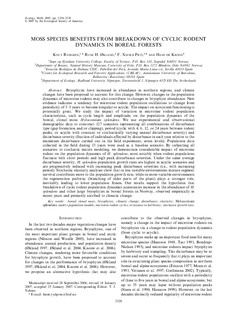| dc.contributor.author | Rydgren, Knut | |
| dc.contributor.author | Økland, Rune H. | |
| dc.contributor.author | Picó, F. Xavier | |
| dc.contributor.author | Kroon, Hans de | |
| dc.date.accessioned | 2007-09-17T12:56:44Z | |
| dc.date.issued | 2007 | |
| dc.identifier.citation | Rydgren, K., Økland, R., Pico, F., & de Kroon, H. (2007, September). MOSS SPECIES BENEFITS FROM BREAKDOWN OF CYCLIC RODENT DYNAMICS IN BOREAL FORESTS. Ecology, 88(9), 2320-2329. | |
| dc.identifier.issn | 0012-9658 | |
| dc.identifier.uri | http://hdl.handle.net/11250/149305 | |
| dc.description.abstract | Bryophytes have increased in abundance in northern regions, and climate changes have been proposed to account for this change. However, changes in the population dynamics of microtine rodents may also contribute to changes in bryophyte abundance. New evidence indicates a tendency for microtine rodent population oscillations to change from periodicity of 3–5 years to become irregular or acyclic. The impact on ecosystem functioning is potentially great. We study the impact of variation in microtine rodent population characteristics, such as cycle length and amplitude, on the population dynamics of the boreal, clonal moss Hylocomium splendens. We use experimental and observational demographic data to construct 127 scenarios representing all combinations of disturbance type (gap formation and/or clipping), period (cyclic with 4, 6, 12, or 24 years between rodent peaks; or acyclic with constant or stochastically varying annual disturbance severity) and disturbance severity (fraction of individuals affected by disturbance in each year relative to the maximum disturbance carried out in the field experiment; seven levels). Population data collected in the field during 13 years were used as a baseline scenario. By subjecting all scenarios to stochastic matrix modeling, we demonstrate considerable impact of microtine rodent on the population dynamics of H. splendens, most notably when rodent populations fluctuate with short periods and high peak disturbance severities. Under the same average disturbance severity, H. splendens population growth rates are highest in acyclic scenarios and are progressively reduced with increasing peak disturbance severities (i.e., with increasing period). Stochastic elasticity analyses show that in less variable environments mature segment survival contributes more to the population growth rate while in more variable environments the regeneration pathway (branching of older parts of the plant) plays a stronger role, inevitably leading to lower population fitness. Our results support the hypothesis that breakdown of cyclic rodent population dynamics accentuates increase in the abundance of H. splendens and other large bryophytes in boreal forests in Norway, observed empirically in recent years and primarily ascribed to climatic change. | |
| dc.format.extent | 223974 bytes | |
| dc.format.mimetype | application/pdf | |
| dc.language.iso | eng | en |
| dc.publisher | Ecological Society of America | en |
| dc.subject | Avdeling for ingeniør- og naturfag | en |
| dc.title | Moss species benefits from breakdown of cyclic rodent dynamics in boreal forests | en |
| dc.type | Journal article | en |
| dc.type | Peer reviewed | |
| dc.source.pagenumber | 2320-2329 | en |
| dc.source.volume | 88(9)2007 | en |
| dc.source.journal | Ecology | en |
